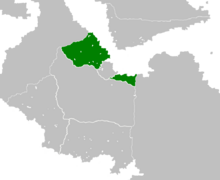Republic of Farstan
This article is incomplete because it is pending further input from participants, or it is a work-in-progress by one author. Please comment on this article's talk page to share your input, comments and questions. Note: To contribute to this article, you may need to seek help from the author(s) of this page. |
Republic of Farstan Komara Farstane | |||||||||
|---|---|---|---|---|---|---|---|---|---|
| 1869–1955 | |||||||||
|
Flag of Farstan (1869 - 1955) | |||||||||
 The borders of the Republic of Farstan 1873 - 1955 | |||||||||
| Status | Republic | ||||||||
| Capital | Capitoli | ||||||||
| Common languages | Basaquese, Santian | ||||||||
| Government | Unitary parliamentary republic | ||||||||
| Chancellor | |||||||||
• 1873 - 1879 | Mirayan Elci | ||||||||
• 1949 - 1955 | Celile Lamangir | ||||||||
| Legislature | Parliament of Farstan | ||||||||
| History | |||||||||
• Declaration of Independence | 19th January 1869 | ||||||||
• Recognition of Independence | 19th January 1873 | ||||||||
• Unification of Liberto-Ancapistan | 21st March 1955 | ||||||||
| Currency | Farstani Fiat | ||||||||
| |||||||||
The Republic of Farstan (Farstani Basaquese: Komara Farstane) was a republic in northern Basaquastan, existing between 1869 and 1955. Located in modern day Peraven Far Province, it was formed of two unconnected regions separated by the Varisil Strip and corresponding to much of the historical region of Farstan.
The republic was declared in 1869 by rebels in the city of Capitoli, during the first phase of the Northern Revolt, based on the example of the Republic of Libertarya. Throughout the four-year conflict, the fortunes of the republic would shift substantially, though for much of its duration it controlled little more than Capitoli and the surrounding hills. Following the Tricolour Revolution in Santia, the republic was recognised as independent, though without the Varisil Strip and still strongly opposed by the Santian general-turned warlord Baram Giacomo. The constitution and government structure of Farstan was modelled strongly on Libertarya, which became a close ally of the republic, and had been the source of significant volunteers and popular funding during the Northern Revolt (including, most notably, the first Libertaryan Chancellor Qasim Kaivan). Farstan was relatively peaceful for much of its existence, sceptical of the pro-unification sentiments which had caused political strife in the other predecessor states of Liberto-Ancapistan. While Farstan saw limited industrialisation, particularly in the major port city of Devisgund, it was never an especially wealthy country. In 1950, during the opening stages of the Great Santian War, Farstan was defeated and occupied, its government going into exile. During its exile, Farstan joined the Liberto-Ancapistanian Alliance and eventually agreed to join Liberto-Ancapistan, though this was unpopular. A brief attempt to revive the independent republic was made in 1957 by nationalist Premier Bachtya Humayan during the Humayan Affair.
